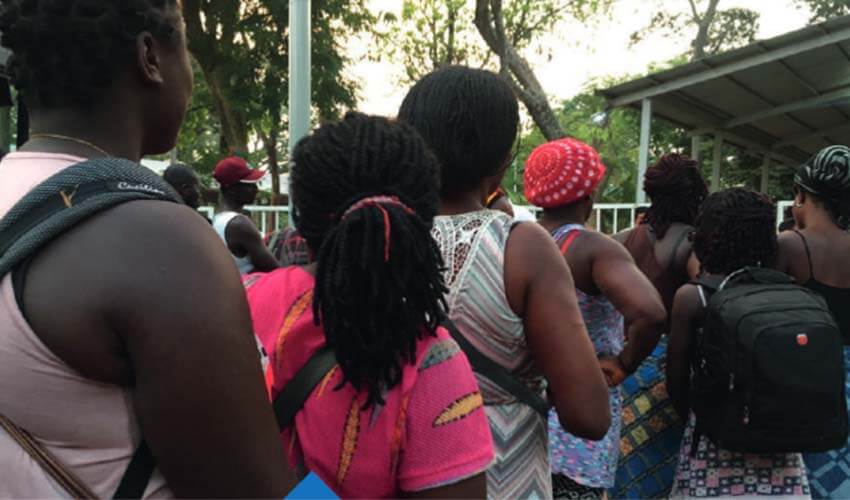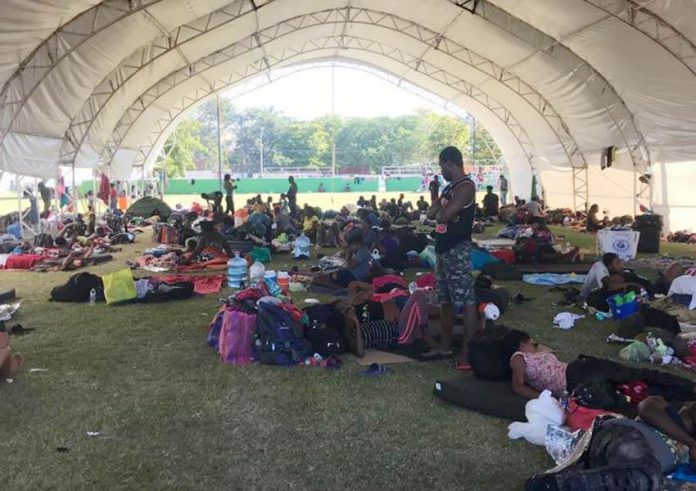In the Ciudad Concordia Sports Center on the outskirts of Campeche, a domed white tent bustles with people: men, women and children weaving between seated groups. Families are sleeping or sitting on mats laid out close together. Laundry is being done in sinks a few meters from the bustle of the sleeping area. Clothes are slung over fences, poles and almost any other vaguely horizontal surface to bake dry in the sun.
A migrant camp in Campeche is a largely unfamiliar sight for most of the residents of the city, but for the people from various countries who are temporarily housed here, this is not the first they have stayed in. They all hope it will be the last.
The National Immigration Institute transferred these migrants from the border city of Tapachula, Chiapas, earlier this month in an attempt to mitigate pressure on immigration officials there. Campeche is just but one example of cities throughout Mexico where INM officials have been moving migrants awaiting legal immigration status in Tapachula. Officials in that border city have been overwhelmed with trying to process thousands of migrants from Central and South America, the Caribbean and elsewhere who keep arriving there from Guatemala.
Despite the cramped quarters here in the Campeche sports center, there were no complaints about conditions or treatment. Both immigration officials and migrants made clear that the migrants are free to leave once their paperwork is processed.
There were, however, some murmuring protests about the speed of the process, which, when including wait times in Tapachula, has taken weeks for the majority here and is still not complete. Without increased resources to aid INM officials here, however, little is likely to change.

The INM office in Campeche is small and ill-equipped to deal with the sudden influx of people requesting regularization paperwork. Three service booths are hardly sufficient for hundreds of individuals keen to move on from here, even with officials manning the tiny office throughout the night.
Due to its isolated position on the Yucatán Peninsula, the state of Campeche has seen little of the movement of people from southern countries seeking a better life. Now, however, according to Ángel Hernández, the INM subdelegate in Campeche, caravans of migrants in Chiapas are being redistributed across the country in an attempt to ease the pressure on immigration services and the infrastructure in Chiapas, the main point of entry to Mexico for the majority of migrants from Central and South America.
Once relocated to other states, migrants are offered a humanitarian visitor visa, valid for a year. This allows them to move freely through the country and work. After their year-long emergency visa has expired, the pathway is open to applications for permanent residency and citizenship in Mexico. It is a policy that, although noticeably more hospitable towards refugees and asylum seekers than has historically been the case in Mexico, seems designed to fail.
Simply redistributing groups of migrants to cities across the country defers rather than deals with the issues facing migrant families: lack of infrastructure, racism, xenophobia and outright persecution, not to mention a plethora of further issues for those who decide to venture on to the northern border with the United States.
Indeed, most of the migrants in the camp do not intend to stay in Mexico; almost nobody in the camp was intending to stay in Campeche, and a very few were planning to settle wherever they could find work. The majority planned to continue north through the country until they reached the United States, regardless of what Mexico was offering in terms of immigration status.
The situation is born of pressure from the United States to legalize migrants in Mexico, with the hope that legal status here will discourage the flow of people continuing northward who believe that Biden’s electoral campaign policies will manifest themselves as a reality through a restored asylum system.

Hernández estimates that there are around 700 migrants currently in Campeche. Of these, around half are originally from Haiti, and the remainder hail from Cuba, Venezuela, Nicaragua and Honduras. The majority of the Haitian migrants currently in the camp have been in “intermediate countries” of Central and South America, living and working on temporary permits in places like Brazil and Chile since 2015 and 2016.
Once the COVID-19 pandemic began, however, work dried up, and people found themselves in desperate situations. Junior, a young man from Haiti, left his home country for Suriname after finishing his degree in agronomy and worked for a year in a beach shop in Suriname.
He speaks about his family in the U.S., whom he is hoping to join once his papers in Mexico are processed. They are sending him remittances to help with the cost of his journey.
“I’m traveling with one other person, and we got stuck in Tapachula for a month, where nothing was happening. All we were told was that we’d be moved eventually because there were too many people in Tapachula,” he said.
“We’ve only been here for two days, and we’re hoping to be able to move on soon, though we’re not exactly sure what the process is,” he added.
Though everyone Junior had spoken to had been in the camp for a few days awaiting their paperwork, he said that there was no sense that people’s needs were being ignored or that they were being made to wait around.
“They’re very patient at [INM],” he said, “and we get meals here, so it isn’t too bad.”
Nevertheless, he is eager to move on. “Once I get my card, I can leave here,” he says with a grin.
Junior’s tale is typical of everyone in the camp willing to discuss their journey: weeks in limbo at the southern border followed by a hasty relocation to Campeche.
Though the situation is far from ideal for any of the involved parties, it is magnitudes more accommodating than the draconian practices of other nations, who continue to treat fleeing migrants with hostility and, in many cases, outright aggression.
Whatever the eventual outcome of each individual’s journey, there is clearly a severe need for increased aid for vulnerable groups of migrants in Mexico, who are being left to figure out their futures in cities they never intended to visit as a way to give governments — here and in the United States — stall time on their immigration policies.
Shannon Collins is an environment correspondent at Ninth Wave Global, an environmental organization and think tank. She writes from Campeche.
